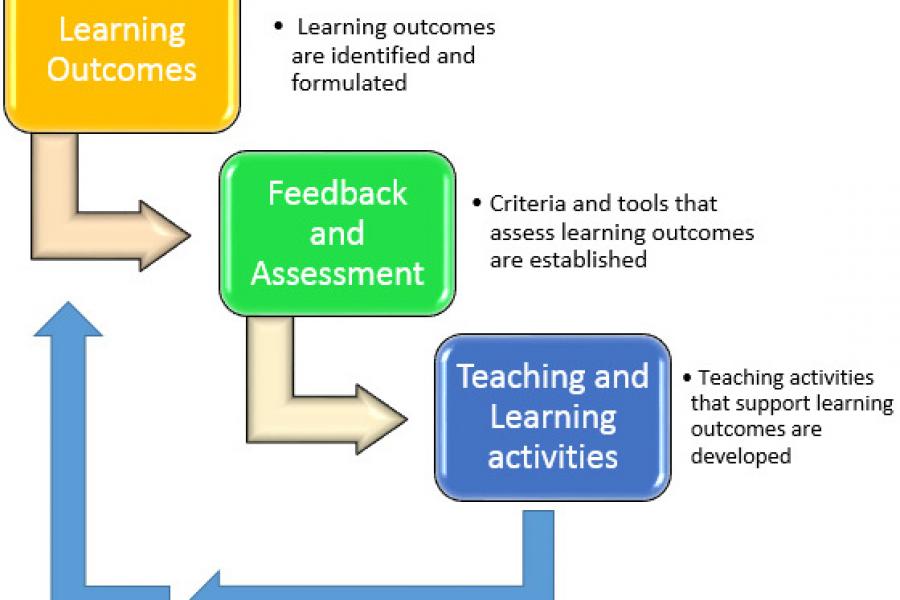Teaching activities need to actively engage students in their learning and must be linked to their learning outcomes. For example, if you want students to learn critical thinking skills, they need to engage in activities in the classroom that promote critical thinking such as debates and focused discussions.
Course alignment
Curriculum alignment in course design starts with the end in mind (Biggs, 1999). It means ensuring that the learning outcomes are in alignment with teaching strategies and assessment.

Introduction
In curriculum alignment, the teacher’s responsibility is to create a supportive and challenging learning environment for all students where the learning activities, assessment tools, and learning outcomes are connected. To do this, the instructor must have a clear idea of what they want the students to be able to do by the end of the course or session.
When matching goals, teaching strategies, and assessment tools, the instructor should consider:
- What are the ‘desired’ outcomes?
- What teaching methods require students to behave in ways that are likely to achieve those outcomes?
- What assessment tasks will tell us if the actual outcomes match those that are intended or desired? (Biggs, 1999)
By teaching a course in which purpose, teaching, and assessment are aligned, a relationship of trust with students is created. When students are told what they should be able to demonstrate (learning outcomes), but are not assessed on these outcomes, they understandably feel confused and cheated. When teachers have clear learning outcomes, teach to and assess those outcomes, they may build a trusting relationship with their students.
Achieving curriculum alignment
Curriculum alignment is challenging and takes time to achieve. Reflection on teaching practice is essential in supporting this process. The instructor needs to determine if the way in which content and skills are facilitated and assessed is effective. Are the students understanding what is being taught and is that understanding accurately represented in their assessment? One simple way to answer this question is by asking the students. At the end of any given session many instructors will ask the students to pass them a note or send them a message with a specific question that the teacher may have in their effort to align the curriculum:
- What were some of the main points of this session?
- What concepts are unclear to you?
- Did the purpose that I outlined at the beginning of the session match with what was taught?
- Did you feel that the learning outcomes and teaching in this course were connected to how you were assessed? Please explain.
Creating learning outcomes
Since the process of curriculum alignment begins with the end in mind, it is helpful to consider what students should be able to do by the end of the course. The actions students should be able to perform become the basis of the learning outcomes for the course. Based on Bloom’s taxonomy, learning can occur in different domains:
- Cognitive: content knowledge and the development of intellectual skills
- Psychomotor: physical skill
- Affective: values, attitudes, and identity pertinent to the discipline or profession
Learning outcomes should reflect learning in different domains and represent learning levels from basic to challenging. For example, at the lower level of the cognitive domain students may be asked to list or recall material but at a higher level they could be required to justify or interpret material.
Selecting teaching and learning activities
Creating assessment and feedback
Assessment should naturally attempt to measure how well the student has met the learning outcomes. Assessment has the greatest impact when it is both formative and summative in nature. Formative assessment not only provides ongoing feedback for students, but also measures for the instructor how well the learning outcomes have been achieved. Rubrics that are designed based on the learning outcomes will make the process of assessment more clearly aligned with the outcomes and more transparent for the students. When teaching and learning activities are clearly aligned with assessment, it will result in continuous feedback for both student and teacher.
Alignment table
The following table presents a framework to communicate the alignment of course-level learning outcomes with assessments, teaching and learning activities, as well as how the course level learning outcomes fit within the context of the program or major. This framework can be used to support course design as well as to communicate this alignment to colleagues and students.
| Course-Specific Learning Outcomes What will students know, value, and be able to do by the end of the course? Note: Courses typically have 5-8 learning outcomes. By the end of the course, successful students will be able to: |
Assessment Methods What assessment methods will provide evidence that students have achieved the LO? How will feedback be given to students regarding their achievement of the LO? What assessment methods will need help to inform and improve student progress towards the LO? |
Teaching & Learning Activities (TLA) What TLAs will students actively engage in as they progress towards this learning outcome? What TLAs will help to support students in their ability to achieve the LO? Note: These activities can occur both inside and outside the classroom. |
Alignment with Program or Major Level Learning Outcomes What program-level or major-level learning outcomes does this course-level learning outcome align with? |
| 1) | |||
| 2) |
Video resource
Claus Brabrand (2006): “Teaching Teaching & Understanding Understanding”
(19-minute award-winning short-film on Constructive Alignment).
References
Biggs, J. (2003). Aligning Teaching and Assessment to Curriculum Objectives, Imaginative Curriculum Project, LTSN Generic Centre. https://www.advance-he.ac.uk/knowledge-hub/aligning-teaching-and-assessment-curriculum-objectives
Kenny, N. (2012). Course Design through Constructive Alignment. http://opened.uoguelph.ca
Houghton, W. (2004). Engineering Subject Centre Guide: Learning and Teaching Theory for Engineering Academics. Loughborough, UK: HEA Engineering Subject Centre.
McMahon, T. & Thakore, H. (2006). Achieving Constructive Alignment: Putting Outcomes First. Quality of Higher Education, 3, 10-19.
University College Dublin, Using Biggs’ Model of Constructive Alignment in Curriculum Design. https://snazlan.wordpress.com/2017/04/13/using-biggs-model-of-constructive-alignment-in-curriculum-design/

